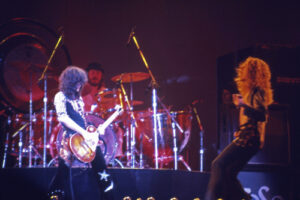
Photo: “3688-David-Gilmour-2015” flickr photo by xiquinhosilva https://flickr.com/photos/xiquinho/27342458864 shared under a Creative Commons (BY) license
There are certain guitarists who harbor a certain mystique about them that makes them easy to distinguish in contrast to most; they hold many peculiarities that puts them in a class all their own. David Gilmour, the mastermind behind Pink Floyd’s universal sound, fits that mold perfectly. He’s one of the few guitarists who can play a single note and the listener can easily identify that it’s him playing it; Gilmour is just that legendary. His organic balance between minimalism and an astronomical theater of reverberation is just one of the endless reasons why he’s one of the greatest guitarists of all time, and one of importance and influence; not since B.B. King has there ever been anybody who could turn vibrato into a vital extension of themselves.
Gilmour joined Pink Floyd in 1967 after the release of their debut psych record with then-front man and founder Syd Barrett; him and Barrett were old friends from school who would jam in their free time. By the time their sophomore record came out, Syd Barrett was already well into his slow decent of madness, so he was ultimately replaced by Gilmour. Nobody can deny the creative genius of Syd, and without him, Pink Floyd never would have existed, but his departure would subsequently lead the band on the inevitable path of musical maturity and worldwide recognition. And with more than 200 million album sales later, that kind of omnipresent love and adoration speaks for itself.
Simply put: David Gilmour was the heartbeat of Floyd’s wonderfully transcendental sound; his delicate touch of the instrument ascends the human consciousness towards the absolute peak of the cosmos. With this list, we’ll highlight some of his greatest guitar work; courtesy of our undying love for Pink Floyd and David Gilmour here at ClassicRockHistory.com.
# 15 – Crying Song
Let’s kick off our list with something simple. When it comes to the Genesis of Floyd’s avant-garde instrumentation, most will point to their 1969 record, More, a soundtrack for the film of the same title, directed by Barbet Schroeder. The band delved into many styles on this album, with Gilmour showcasing his sweet vocals on most of the songs, but one of the standouts here would have to be Crying Song; it’s a shining example of his “less is more” approach. It’s a beautiful and quiet folk ballad with a nice little slide guitar solo that fades out, demonstrating that feeling can leave an impression more so than being a virtuoso.
# 14 – Atom Heart Mother
Something that should be noted is that Pink Floyd is a progressive rock band, so most of their catalog comprises 20-minute suites; not to make this list overly redundant, but you’ll see a few more of these songs on this list. Released in 1970, Atom Heart Mother proved to be their most polarizing record until later re-evaluation; the playful experimentation of the avant-garde on the title track was too much to take in then. Not only are Gilmour’s guitar riffs and licks fascinating, but the 23-minute-long track itself unfolds like an unpolished epic; each band member creates a story with their styles that turn Atom Heart Mother into a wild adventure. And who can overlook the iconic album cover of the cow in the grassy meadow? That cover even appears in a scene from Stanley Kubrick’s film, A Clockwork Orange.
# 13 – The Gold It’s in the……:
Gilmour is well-known for his mellow and space-like melodies, but early on in his career, he was absolutely on fire when it came to spitting out those galvanizing blues runs dipped in hot distortion; this song is evidence of such. It’s one of the few Floyd tunes with a more generic and straightforward rock sound, which is a nice break from their more thought-provoking pieces. Gilmour is a beast on this track, for sure. Obscured by Clouds, released in 1972, is an album worthy of recognition for being the precursor to one of the greatest albums of all time, which would soon exist a year later.
# 12 – The Nile Song
But once in a blue moon, being a virtuoso can come in handy; that’s the case here. This other More soundtrack cut is perhaps Pink Floyd’s heaviest song of their career; it is an uncontrolled explosion of inconceivable magnificence. Gilmour lets the listener know he’s in charge, grabbing us all by the scruff with his nasty guitar licks and shaking us frantically until the song’s end.
# 11 – High Hopes
Their 1994 album, The Division Bell, saw the band correcting the mistakes of their previous album, A Momentary Lapse of Reason
. It’s quite an overlooked record, and the ending composition, High Hopes, makes up for the album even if you despised every other song. It’s both one of their most depressing and uplifting songs, and that slide guitar solo that ends the song is Gilmour at his best; it’s doused in emotion, which is of course, his signature trait, but it also has a particular technicality to it in the way in which he sustains each note, making the guitar sound like one big mournful cry.
# 10 – Let There Be More Light
This is a significant song and guitar solo, mainly because it was David Gilmour’s very first recorded song with Pink Floyd once he joined. Let There Be More Light, the opening track from their 1968 record A Saucerful of Secrets, has quite the kaleidoscopic groove; there’s also an excellent reference to the Beatles’ Lucy in the Sky with Diamonds in the song. But it’s Gilmour’s solo at the very end that sets the tone for the band’s newfound career, and for that, we honor his guitar work here.
# 9 – Another Brick in the Wall Part 2
We couldn’t neglect Pink Floyd’s magnum opus, The Wall. A scintillating representation of Gilmour’s signature sound lies within this well-known classic rock staple. This is the song and album that introduced many, many, many fans to the bands; who wouldn’t fall in love after hearing this anti-establishment protest towards a broken school system? But let’s be honest: the song wouldn’t hold up like it does without Gilmour’s guitar solo.
# 8 -Money
Well, everybody who knows classic rock knows about this funky and hard-hitting tune; I’m sure most of you are also aware that it’s one of the singles from a little album called The Dark Side of the Moon. Money isn’t just renowned for Gilmour’s uproarious guitar solo; it’s also a pretty complex composition. It was recorded in an odd time signature of 7/4, with an abrupt switch to 4/4 once the solo begins. The song’s lyrical content touches on mindless materialism and has never sounded more relevant today. But that guitar solo? Oh, man, that’s what you call pure tastefulness.
# 7 – Dogs
Pink Floyd’s 1977 concept album Animals is one of their greatest. It was loosely inspired by George Orwell’s Animal Farm, with Roger Waters using animals as a symbol for the many layers of social classes. With Dogs, the allegory pertains to the ruthless upper class of capitalism. The song, clocking in at 17 minutes, is a captivating story, but Gilmour’s guitar solos, especially his second one during the midsection, are the true highlights.
# 6 – Shine on You Crazy Diamond:
Wish You Were Here is not only a critique of the music business but also a fitting tribute to Syd Barrett; this is where Shine On comes into play. The song is broken up into two parts, which bookends the record, but we will acknowledge the suite as a whole; at 26 minutes, Shine On is the band’s most extended recording.
Gilmour creates a grim atmosphere in the beginning with his lovely blues runs before slowly elevating the suite into a bittersweet farewell to a tortured genius. And just because it was written for Syd doesn’t mean it can’t speak on a universal level—because it does.
#5 – Have a Cigar
This is the greatest Pink Floyd song to feature another singer who wasn’t Roger Waters or Dave Gilmour. They had trouble getting the vocals right while recording the song at Abbey Road studio. Folk musician Roy Harper was in the same studio recording his album, where he then noticed Floyd’s recording and offered to lend his vocals for the song. Have a Cigar is a true classic, and Gilmour’s guitar solo is pure coitus to the ears. This song was released from their 1975 opus, Wish You Were Here.
# 4 – Time
Here’s another famous Dark Side of the Moon cut home to one of his most famous guitar solos, much like with Money. This is perhaps Floyd’s single most depressing song, which generally sums up life. But it’s also excellent, and it’s mainly due in part because of Gilmour’s guitar solo. How he accentuates each note and string bends with his singular form of vibrato and chooses the suitable passages proves that you can tell a story and leave an impression as a guitarist without playing a million notes fast.
# 3 – Pigs (Three Different Ones)
It should be noted that Animals is Gilmour’s greatest guitar work. With this song, he has not one but two impressive solos. The first one, which begins during the middle break, features Gilmour utilizing the talk box in his way; he also mimics the grunts and growls of a pig, which is pretty clever. But the big finale is his closing solo, which will literally send shivers up your spine. Even live performances of the solo are worth singling out.
# 2 – Comfortably Numb
Speaking of sending shivers up one’s spine, here’s a song and guitar solo that does just, but at a more conscious level. Comfortably Numb is one of the Wall’s biggest hits and one of Floyd’s most iconic tunes, and Gilmour’s guitar solos here, especially the last one, have long been hailed as his best work; that’s a true statement. Don’t let the number 2 spot fool you: This is Dave’s greatest guitar solo; it has every quality that makes him one of the best. But it’s not only his studio solo that’s amazing, but also his live performance during Pink Floyd’s 1995 Pulse concert; that guitar solo isn’t merely listening to it, but “experiencing” it.
# 1 – Echoes
Going back to what was said about Comfortably Numb. Having it at the number 2 spot doesn’t mean it shouldn’t be number 1. In a way, these two songs are tied for the number one spot; Echoes is holding down this slot simply for being 23 minutes of pure euphonious heaven.
Released on the 1971 record Meddle, Echoes was the composition that helped Floyd find their initial sound and turned them into a serious and highly respected band. The song’s structure, like all progressive rock suites, is broken up into several pieces. It starts out with a slow build-up of haunting sound experimentation until it goes right into the slow and peaceful progression along with Gilmour’s mesmerizing vocals. Then the song grows bigger with more rock-oriented conventions as Gilmour breaks out into an extended guitar solo that combines aggression, groove, soul, and sinister.
Once the solo ends, we’re treated to quite an ominous guitar effect that was a result of Gilmour accidentally plugging in his wah pedal cables the wrong way; those high-pitched seagull/whale-like screams were achieved by toggling the volume knobs. After that section ends, the tensions rise as soon as Gilmour comes in with some fast-paced, palm-muted notes before exploding into an endless stream of arpeggiated harmonies. Finally, the song shifts back into the main verse again.
The kind of hodgepodge of atmospheric emotion Gilmour illustrates in Echoes is truly remarkable; this song and “Comfortably Numb” are his masterpieces.
Read More: Ultimate Pink Floyd Page: Complete History, Songs, Albums & More




































Good article about one of Rock’s most overlooked brilliant guitarists.
I would have to include David in the top ten.
Great selection of songs. I think you actually picked 10 number ones.
If there is one that speaks to me the most, it would probably be “Dogs”.
With 3 amazing solos, a lyrical and musical masterpiece, to me it is 17 plus
minutes or pure bliss.
Anyway good job. It was nice to hear Echos again. That song was definetly a
turning point in Pink Floyd’s sound (the shape of things to come if you will)
Take care.
Could not have said it much better than expressed above, by Tom.
I would only add that David Gilmour is one of the most tasteful, cerebral, escapist, and discerning guitarists of all of rock history.